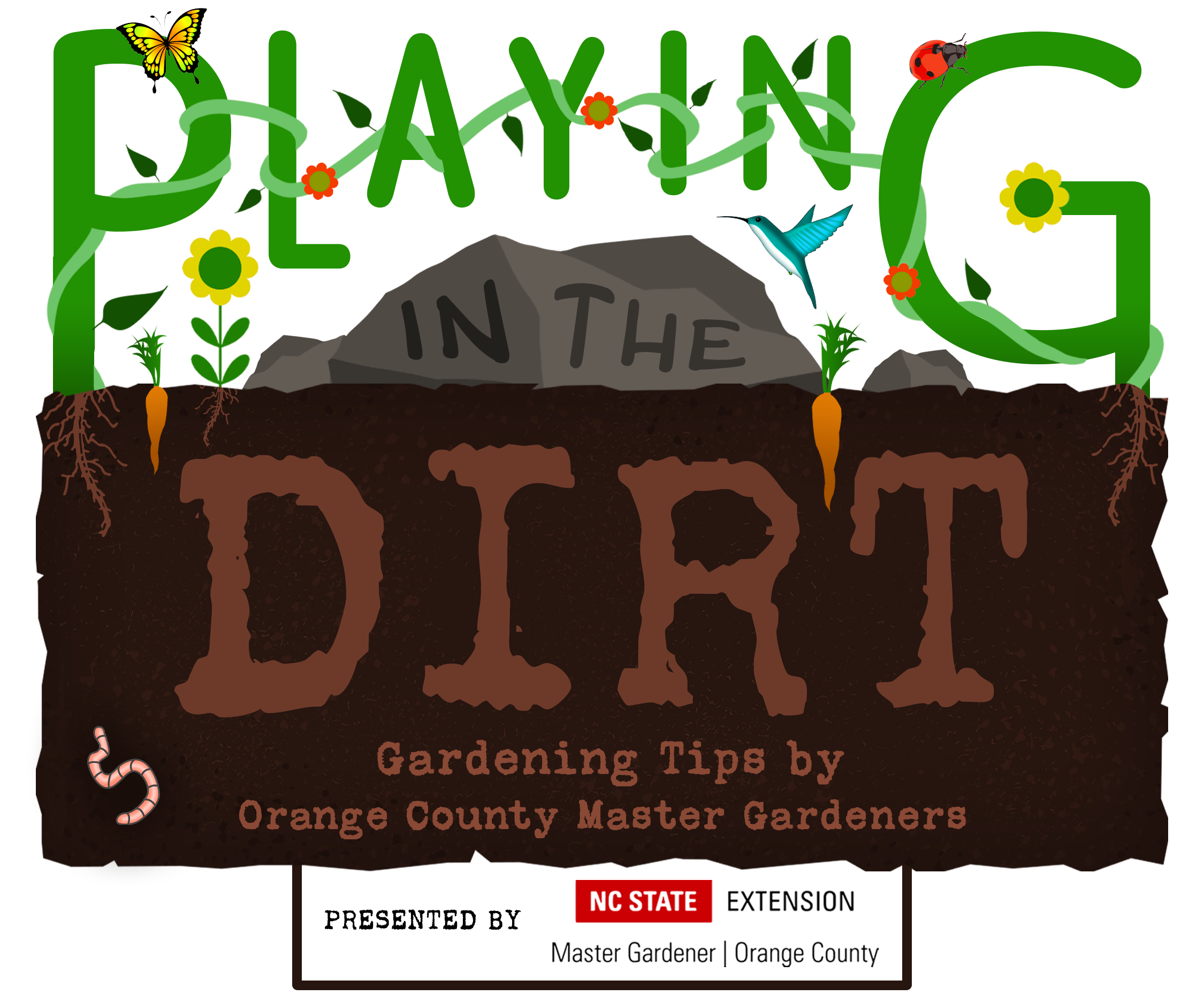
97.9 The Hill and Chapelboro.com have partnered with Orange County Master Gardeners for “Playing in the Dirt,” a monthly column exploring the fertile ground of home gardening in our community and intended to provide the information and inspiration gardeners of all skills levels need to flourish! Check back on Chapelboro each month for a new subject – from our gardens to yours!
By Pat Collins, Orange County Master Gardener Volunteer
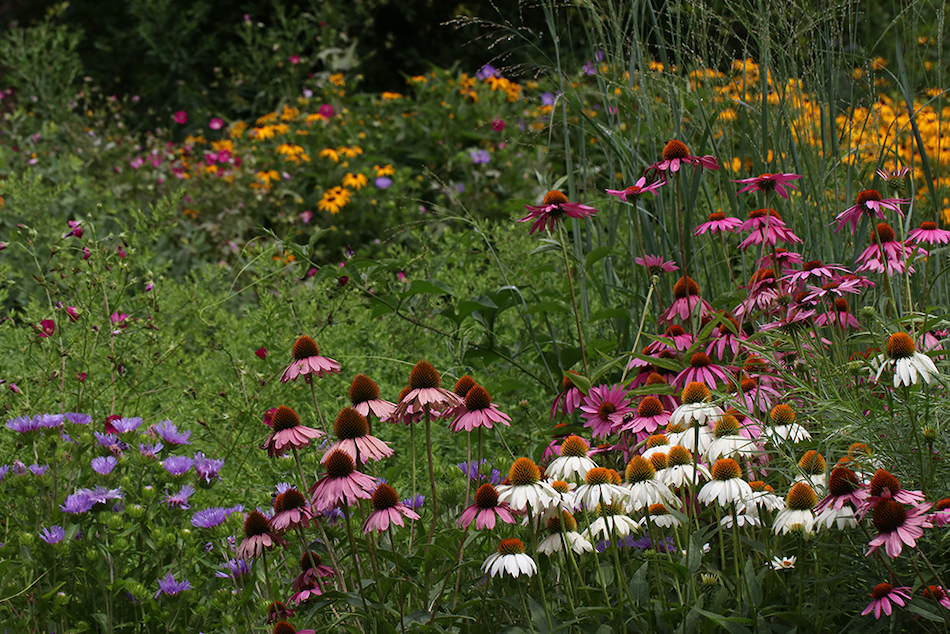
Early summer blooms at the Pollinator Paradise Demonstration Garden in Pittsboro, where 85% of the garden’s plants are natives. Debbie Roos, NC Cooperative Extension, Chatham County Center.
April is National Native Plant Month. A great way to celebrate and help the environment is to add some native plants to your yard!
Native plants are those that originated in a region and developed there over thousands of years. They have adapted to soil and weather conditions over time and will thrive without a lot of extra care. They provide food, shelter and habitats that are essential for birds, native bees and other beneficial insects, and other wildlife.
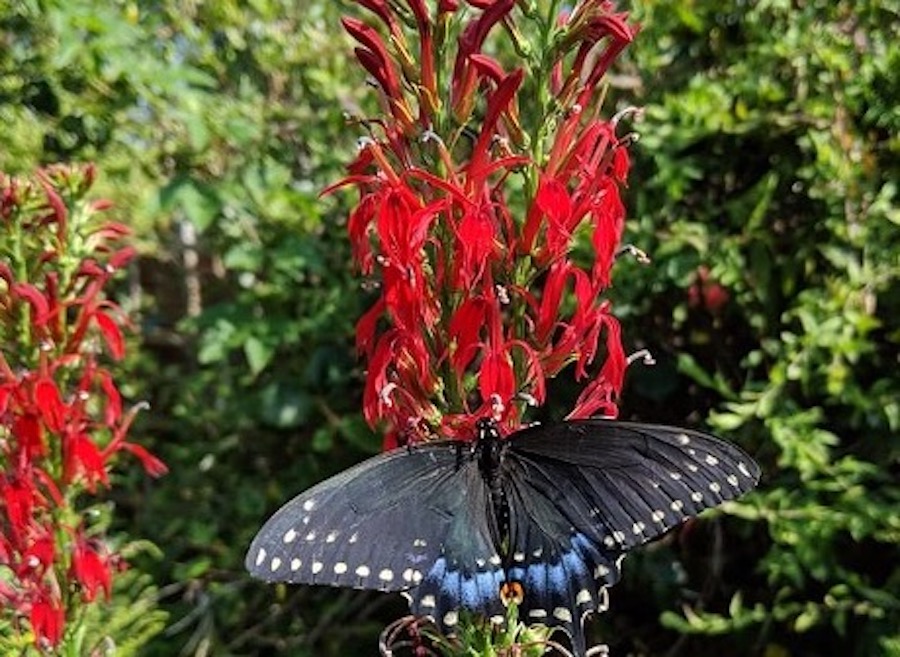
Black swallowtail butterfly on cardinal flower (Lobelia cardinalis). Debbie Roos, NC Cooperative Extension, Chatham County Center.
Why Go Native?
Plants are not just decorations. They are part of the sustenance for a broad array of insects, animals and plants that have evolved over centuries and are part of a specific ecosystem. Introducing plants from elsewhere disturbs the delicate balance that keeps the ecosystem healthy.
A lack of native plants creates a food desert for all the organisms that depend on their natural habitat. Insects have evolved with specific requirements. For example, the larvae of the monarch butterfly depend on milkweed as hosts. The monarch butterfly is in decline due to loss of habitat, pesticide use and development. Milkweed (such as Asclepias tuberosa or A. incarnata) is a native plant in North Carolina, is happily deer-resistant and has flowers whose nectar attracts a variety of pollinators: bees, butterflies and beetles.

Carpenter-mimic leafcutter bee on purple milkweed. Debbie Roos, NC Cooperative Extension, Chatham County Center.
Most pollination is carried out by native pollinators — including flies, beetles, moths and butterflies — but native bees are the unsung heroes. (Note that honey bees are not native to North America. While honey bees are used for crop pollination, they are not important to ecosystems.) There are over 4,000 species of bees native to North America and they are important pollinators. However, this bee population is at risk due to pesticides, diseases and habitat loss.
Bees need access to flowers in bloom throughout the year for their necessary nourishment. To offer something for everyone, plant a diversity of native plants, with a variety of shapes, sizes and flower colors. Bees can’t see red, which attracts hummingbirds and butterflies. Bees are drawn to purple, blue, white and yellow flowers.
Native bees need more than pretty flowers to survive. They also need water, shelter and nesting sites. Native bees often live alone in nests in soil, wood or hollow plant stems. To encourage bees to nest, leave open patches of soil or fallen logs in your yard and don’t use pesticides.
Assess Light and Soil Conditions
If you are just starting out with native plants, look for information on plants and their growing conditions. Two good sources are the North Carolina Extension Gardener Plant Toolbox and the North Carolina Native Plant Society’s website (links below). Visit the North Carolina Botanical Garden, Duke Gardens or the Chatham Mills “Pollinator Paradise” Garden to see native plants growing.
Assess the site where your plants will live and thrive. To select appropriate plants, find out how much sunlight the area gets and whether the soil is dry or moist.
Take soil samples for testing using kits available at a county Cooperative Extension office (information below). The test results show the quality of your soil and amendments that are needed.
Prepare the Bed
To prepare a new garden bed, consider one of the following methods to get started: solarization and lasagna gardening.
To begin solarization, water the garden bed well, cover with clear plastic and let the sun’s rays kill all the plant life. This can take several months and will work if you can wait until the early spring of the next year to plant.
Lasagna gardening starts with placing sheets of cardboard on the bed and covering it with soil on top for planting. The cardboard deprives all vegetation underneath it from light and oxygen; it gradually decomposes as the garden becomes established in the topsoil and the roots grow deeper.
Choose Plants
Plan for visual interest. Choose at least three native flowering plants for each season, spring through fall. Match the plants you choose to the sunlight, soil and moisture conditions in your garden, which is a microclimate within the broader area of your property.
To keep maintenance to a minimum, select plants with similar water needs so one part of the garden won’t have to be watered more than another part.
When you choose native plants, pay attention to their growth habits. Some native plants grow large or spread rapidly — these would be better for a meadow than a small garden.
Chapter 12 of the North Carolina Extension Gardener Handbook has lists of North Carolina native plants and when they bloom.
Some garden centers sell cultivars of native plants (“nativars”). These are native plants that scientists cultivated through selective breeding for particular traits such as size or color, though these traits sometimes reduce attractiveness to insects. You can spot cultivars by checking the plant label — a cultivar has a name in quotation marks after the scientific name (for example, a variety of coneflower is Echinacea purpura ‘Harvest Moon’).
Native plants have developed traits in response to growing conditions in the wild and this biodiversity allows some plants to survive attacks or climate conditions that kill other plants. It is OK to plant cultivars but also include plenty of straight native species of plants, which will provide the most benefits to insects and wildlife.
Organizations such as the North Carolina Native Plant Society and the NC Botanical Garden provide lists of native-plant nurseries on their websites. The NC Wildlife Federation provides native seeds for a 25-square-foot area for $10.00.
Planting and Watering
When planting young native plants, dig holes twice as large as the root balls and backfill with native soil. No fertilizer is needed. They will need a lot of water in the first two to three weeks but after that, they shouldn’t need more than what is provided by rainwater. Use of a compost dressing is helpful.
Invasive Plants
The counterpoint of native plants are invasive, non-native plants. Examples are Bradford pear and Chinese privet. Invasive plants were often planted for their decorative value but they cause significant damage to ecosystems, habitats and native species. Invasives spread rapidly, and once established, they decrease the diversity of native plants and the species that depend on them. Avoid introducing invasive plants into your yard or garden. Control of established invasives may require persistence over several seasons.
Remember:
Native plants are low maintenance, provide beauty, are healthy for people (because we can avoid using pesticides and other poisons), help the climate, conserve water and provide a vital habitat for birds, insects and other wildlife!
Additional Resources
- Native Plants, video made by Orange County Master Gardener Volunteers. Explains benefits of native plants and how to create a native plant landscape.
- North Carolina Extension Gardener Plant Toolbox. Searchable information on North Carolina plants, including native pollinator plants.
- North Carolina Native Plant Society. Searchable plant gallery and lists of plants recommended for our region.
- Native Pollinator Perennial and Annual Flowers. North Carolina Wildlife Federation.
- Controlling Invasive Plants. North Carolina Botanical Garden.
- Native Species or Cultivars of Native Plants – Does It Matter? Susan Martin, Piedmont Master Gardeners, Charlottesville, VA.
- A Gardener’s Guide to Soil Testing. NC State Extension. (Soil test boxes are available at the Bonnie B. Davis Environment and Agriculture Center in Hillsborough.)
- The Southeast Native Plant Primer (book), by Larry Mellichamp, Will Stuart and Paula Gross. Timber Press, 2020.
Check us out!
Have a plant or garden question? Email the Orange County Master Gardener Volunteers at ocmgardeners@gmail.com or phone 919-245-2061.
Subscribe to The Garden Buzz, the Orange County Master Gardeners’ monthly newsletter, for local gardening news, events and tips. And visit our website, The Orange Gardener.
Join us! Would you like to learn more about plants and share your knowledge with the community? A new training class for Orange County Master Gardener volunteers will start in September. Gardening experience is welcome but not necessary. Applications and information are available here and are due by May 31.
Save the date: The Orange County Master Gardener volunteers will hold PlantFest, a plant sale and festival, on Oct. 8, 2022, 9 a.m. to 2 p.m., at the Bonnie B. Davis Environment and Agricultural Center, 1020 US 70 W, Hillsborough, NC 27278.
Chapelboro.com does not charge subscription fees, and you can directly support our efforts in local journalism here. Want more of what you see on Chapelboro? Let us bring free local news and community information to you by signing up for our biweekly newsletter.

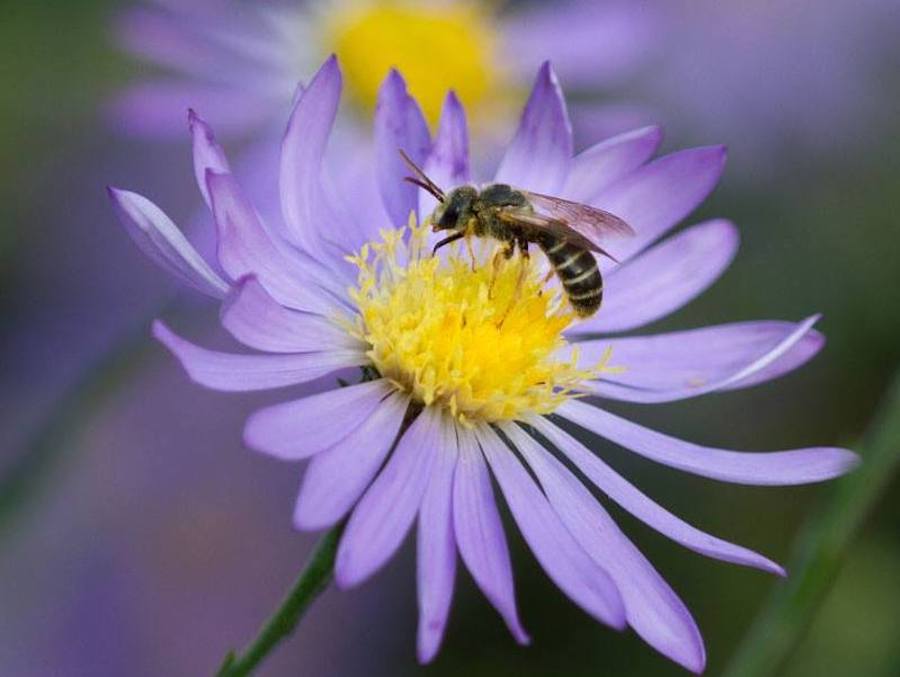
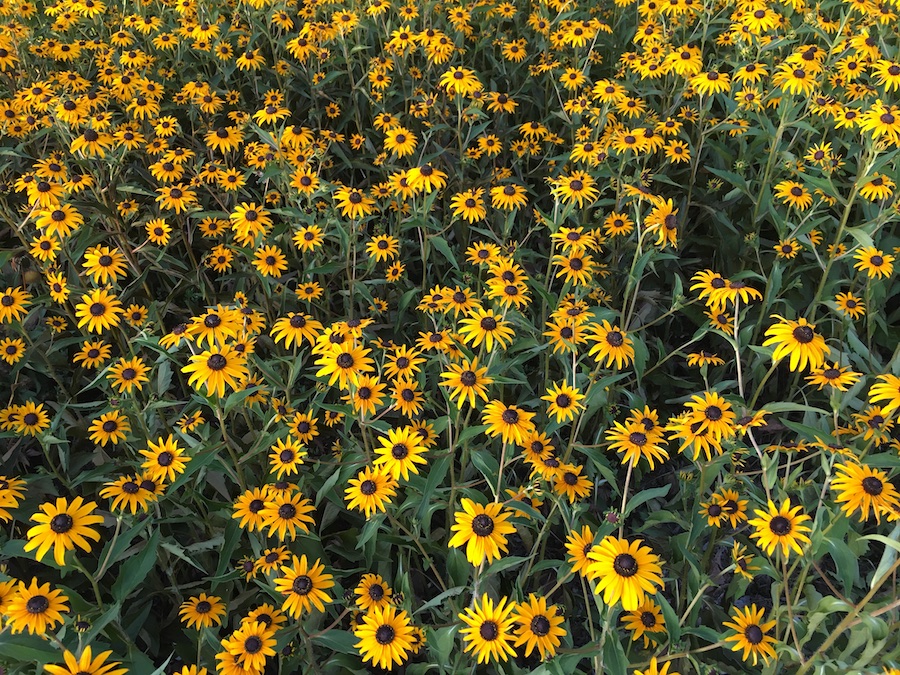
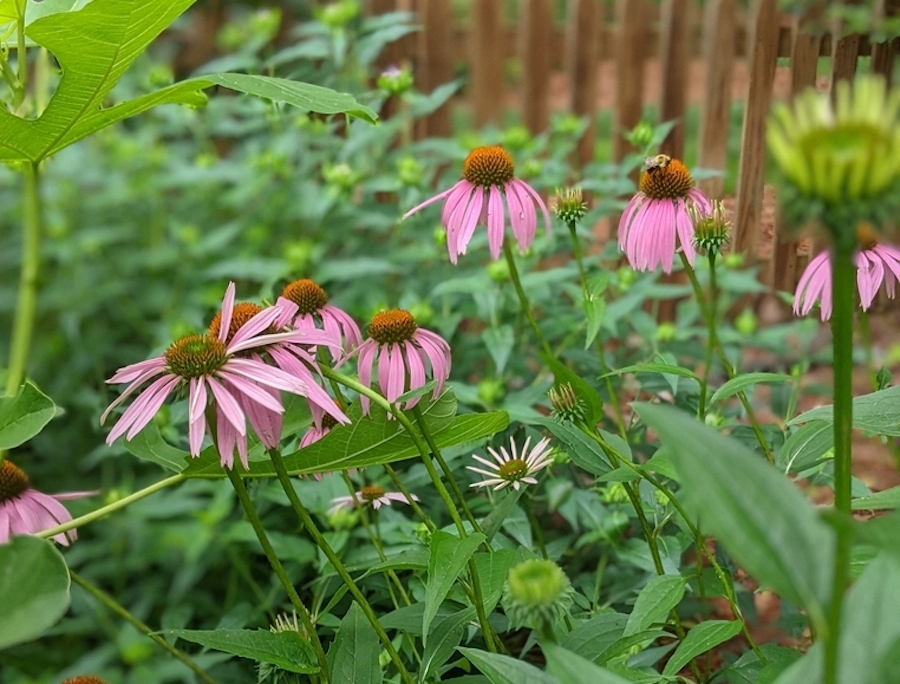


Comments on Chapelboro are moderated according to our Community Guidelines